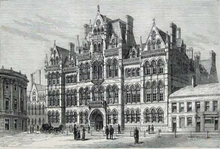Adrian John Brown, FRS (27 April 1852 – 2 July 1919[1]) was a British Professor of Malting and Brewing at the University of Birmingham and a pioneer in the study of enzyme kinetics.
Adrian John Brown | |
|---|---|
| Born | 27 April 1852 Burton-on-Trent, Staffordshire, England |
| Died | 2 July 1919 (aged 67) |
| Education | Royal College of Science, London |
| Known for | Explaining enzyme action in terms of saturation |
| Relatives | Horace Tabberer Brown (half-brother) |
| Scientific career | |
| Fields | Malting and brewing, fermentation, enzyme action |
| Institutions | Burton-on-Trent; St Bartholomew's Hospital, London; Mason University College, now University of Birmingham |

He was born at Burton-on-Trent, Staffordshire to Edwin Brown, a bank manager in the town. His elder brother was Horace Tabberer Brown. He attended the local grammar school and then went up to study chemistry at the Royal College of Science in London. He became private assistant to Dr Russell at St Bartholomew's Hospital Medical School. In 1873 he returned to Burton to work as a chemist in the brewing industry for the next twenty-five years. In 1899[2] he left to become Professor of Brewing and Malting at Mason University College (which became Birmingham University in 1900).[3]
He studied the rate of fermentation of sucrose by yeast and suggested in 1892 that a substance in the yeast might be responsible for speeding up the reaction.[4] This was the first time enzymes were suggested as separate entities from organisms and talked about in chemical terms. He later studied the enzyme responsible and made the striking suggestion that the kinetics he observed were the result of an enzyme–substrate complex being formed during the reaction,[5] a concept that has formed the basis of all later work on enzyme kinetics.[6] Similar ideas had been put earlier by German chemist and Nobel laureate Hermann Emil Fischer by comparing substrate and enzyme with a key and a lock.
References
edit- ^ See Royal Society Record here
- ^ "Chairs and Professors of Universities in the United Kingdom". Who's Who Year-book for 1908. 1908. p. 132.
- ^ Knecht, E.; Thorpe, T. E.; Trigger, O.; Robertson, R. (1922). "Obituary notices: James Robert Appleyard, 1870–1921; Adrian Brown, 1852–1919; William Gowland, 1842–1922; Prof. Philippe A. Guye, 1862–1922; William Kellner, 1839–1922; George William Mac Donald; Lionel William Stansell, 1861–1922". J. Chem. Soc. Trans. 121: 2898–2916. doi:10.1039/CT9222102898.
- ^ New Beer in an Old Bottle: Eduard Buchner and the Growth of Biochemical Knowledge Archived 13 December 2010 at the Wayback Machine, edited by Athel Cornish-Bowden and published by Universitat de València (1997) ISBN 84-370-3328-4, A history of early enzymology.
- ^ A. J. Brown A J: Enzyme action, J. Chem. Soc. 81 (1902) 373–388
- ^ Harden A (1 February 1920). "Obituary Notice: Adrian John Brown". Biochem. J. 14 (1): 1–3. doi:10.1042/bj0140001. PMC 1258887. PMID 16742879.
External links
edit- A Brief History of Enzyme Kinetics Archived 10 February 2007 at the Wayback Machine